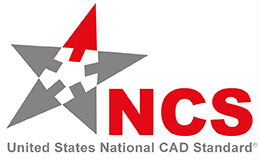New in the United States National CAD Standard®–V6
Released in September 2014, NCS V6 provides the following improvements:
- New "BIM Implementation" guidelines on successful implementation of NCS for BIM use. Addressing relevant topics within the NCS that can be incorporated within BIM workflow.
- Improved style format applied to the body of the standard to properly number chapter and subchapter headings
- Enhanced, revised and improved Symbols library:
- All 1300+ NCS Symbol CAD files replaced and renamed:
- All symbols renamed with a unique 3 digit extension number and abbreviated name
- All symbols converted to inches
- Include new insertion points
- Include line type and pattern file type definitions where appropriate
- Individual symbols linked to corresponding drawing file
- 72 new and 40 revised symbols:
- 18 revised symbols in Division 01 – General Requirements
- 10 revised symbols in Division 21 – Fire Suppression
- 6 new symbols in Division 22 – Plumbing
- 10 new symbols in Division 26 – Integrated Automation
- 43 new symbols in Division 27 – Communications
- 9 revised symbols in Division 28 – Electronic Safety and Security
- Two new Symbols chapters:
- How to create new symbols
- Using colors in symbols
- All 1300+ NCS Symbol CAD files replaced and renamed:
- New "Survey/Mapping" Discipline Designators
- New Major and Minor Groups definitions added for "Airports and Plumbing".
- Revised "Module 1 – File Naming? section to better address Model Files and Sheet Files.
- Revised "Module 4 – Drafting Conventions, 4.2 Drawing Standards" list of common scales to add Site/Civil scale descriptions.
- Revised "Module 4 – Drafting Conventions, 4.3 Sheet Types" section to include new "Floor Numbering" format.
- New and revised "Communications Terms and Abbreviations".
- Revised "Module 7 – Notations, 7.4 User's Guide" text format for notes.
- Revised "Plotting Guidelines" Introduction.
- Apendixes:
- Updated Appendix F – NCS Rules of Governance. Allowing Task Team members to vote on their own ballots during task team reviews.
